

Math-art. The Golden Beauty: Brain Response to Classical and Renaissance Sculptures. Is there an objective, biological basis for the experience of beauty in art?
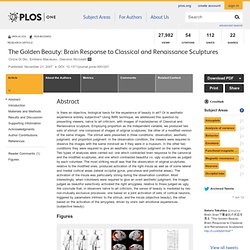
Or is aesthetic experience entirely subjective? If Famous Artists Had Drawn Hand Turkeys. Art, philosophy of : Art as a means to truth or knowledge. Art as a means to truth or knowledge.

Art & Truth. Art and Truth Though not traditionally a major topic within aesthetics, the relationship between truth and works of art is of considerable interest in the context of Theory of Knowledge.
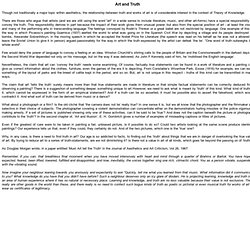
There are those who argue that artists (and we are still using the word “art” in a wide sense to include literature, music, and other art-forms) have a special responsibility to convey the truth. Art and Truth. Art, Mere Things, and Truth Requirements In his book The Transfiguration of the Commonplace, Arthur C.
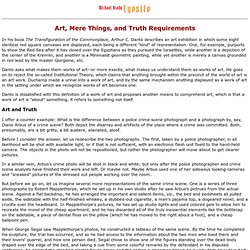
Danto describes an art exhibition in which some eight identical red square canvases are displayed, each being a different "kind" of representation. One, for example, purports to show the Red Sea after it has closed over the Egyptians as they pursued the Israelites, while another is a depiction of the center of the Kremlin, and another is a Minimalist geometric painting, while yet another is merely a canvas grounded in red lead by the master Giorgione, etc. Giant human statue from Iron Age unearthed. Ken Perenyi, Art Forger, Now Sells His Work as Copies. Bamiyan Buddhas: Should they be rebuilt? 12 August 2012Last updated at 19:44 ET By Stephanie Hegarty BBC World Service The destruction of Afghanistan's Bamiyan Buddhas in 2001 led to global condemnation of the Taliban regime.
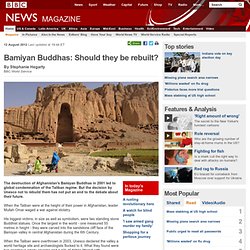
But the decision by Unesco not to rebuild them has not put an end to the debate about their future. When the Taliban were at the height of their power in Afghanistan, leader Mullah Omar waged a war against idolatry. His biggest victims, in size as well as symbolism, were two standing stone Buddhist statues. Once the largest in the world - one measured 55 metres in height - they were carved into the sandstone cliff face of the Bamiyan valley in central Afghanistan during the 6th Century. When the Taliban were overthrown in 2003, Unesco declared the valley a world heritage site and archaeologists flocked to it. Let us above be politically correct . . . Some years ago one of those correct persons who infest modern life pointed out to a bottling company that the label on one of their jams was politically incorrect.
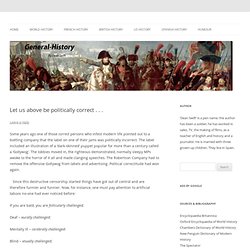
The label included an illustration of a ‘dark-skinned’ puppet popular for more than a century called a ‘Gollywog’. The lobbies moved in, the righteous demonstrated, normally sleepy MPs awoke to the horror of it all and made clanging speeches. The Robertson Company had to remove the offensive Gollywog from labels and advertising. Political correctitude had won again. Since this destructive censorship started things have got out of control and are therefore funnier and funnier. If you are bald, you are follicularly challenged; Deaf – aurally challenged; Mentally ill – cerebrally challenged: Blind – visually challenged; Stupid – intellectually challenged; A dwarf – vertically challenged; Lame – physically challenged; Poor – financially challenged Crooked – ethically challenged; Illegitimate – parentally challenged.
Science & Shelley: What Mary Knew. Patricia Fara explores the scientific education of Mary Shelley and how a work of early science fiction inspired her best-known novel Frankenstein.

Manuscript page from 'Frankenstein'Ever since Boris Karloff’s striking film performance in 1931, Mary Shelley’s Frankenstein (1818) has symbolised everything that seems bad or frightening about science – the atomic bomb, genetically modified foods, luminous transgenic animals. But, when the teenage author dreamt up her plot and her characters, she was commenting on her own experiences rather than designing a manifesto for the future.
Science & Shelley: What Mary Knew. Theoretical physics and the art of the abstract - physics-math - 01 March 2011. Learning About Art: Contents. Learning About Art: Defining Art (1) Learning About Art: Defining Art (2) These images represent two views of Notre Dame Cathedral in Paris, completed in 1345 after 182 years of construction.
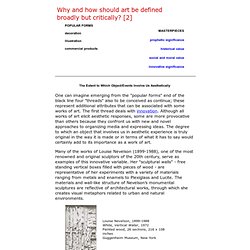
Such extraordinary structures were built without benefit of either steam or electric power. Medieval cathedrals stand today as monuments to the skill, ingenuity and commitment of the hundreds of carefully trained workers who labored to build these magnificent structures. It was during the middle ages that the Guild System emerged. Apprentices worked with master artisans and craftsmen until they acquired sufficient knowledge and skill to travel about the countryside (as Journeymen) seeking their own commissions, which would eventually be submitted for evaluation by the Masters for entry into their Guild. Only Masters were allowed to employ Apprentices.
Such medieval structures were physical manifestations of prevailing beliefs in a literal, heavenly paradise which would be the ultimate reward for being a true believer and living morally and righteously. Learning About Art: Defining Art (3) The third thread stands for historical significance.
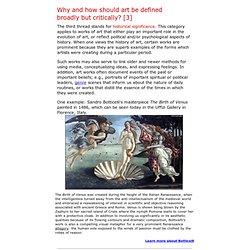
Learning About Art: Defining Art (4) Learning About Art: Definig Art (5) Why do we classify some utilitarian and non-western forms as works of art?
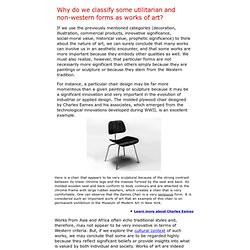
If we use the previously mentioned categories (decoration, illustration, commercial products, innovative significance, social-moral value, historical value, prophetic significance) to think about the nature of art, we can surely conclude that many works can involve us in an aesthetic encounter, and that some works are more important because they embody other qualities as well. We must also realize, however, that particular forms are not necessarily more significant than others simply because they are paintings or sculpture or because they stem from the Western tradition.
For instance, a particular chair design may be far more momentous than a given painting or sculpture because it may be a significant innovation and very important in the evolution of industrial or applied design. Learning About Art: Aesthetic Analysis (2) 1. Two women with vague facial features are depicted. Adam Kirsch: Art Over Biology. Before 2013 begins, catch up on the best of 2012. From now until the New Year, we will be re-posting some of The New Republic’s most thought-provoking pieces of the year.
Enjoy. Why Lyrics Last: Evolution, Cognition, and Shakespeare’s Sonnets By Brian Boyd (Harvard University Press, 227 pp., $25.95) Wired for Culture: Origins of the Human Social Mind By Mark Pagel (W.W. Norton, 416 pp., $29.95) The Age of Insight: The Quest to Understand the Unconscious in Art, Mind, and Brain, from Vienna 1900 to the Present By Eric R. I. In associating art with loneliness, sorrow, and death, Mann was not presenting a new idea but perfecting an old tradition. Art and Epistemology The relationship between art and epistemology has been forever tenuous and fraught with much debate.
It seems fairly obvious that we gain something meaningful from experiences and interactions with works of art. It does not seem so obvious whether or not the experiences we have with art can produce propositional knowledge that is constituted by true justified belief.